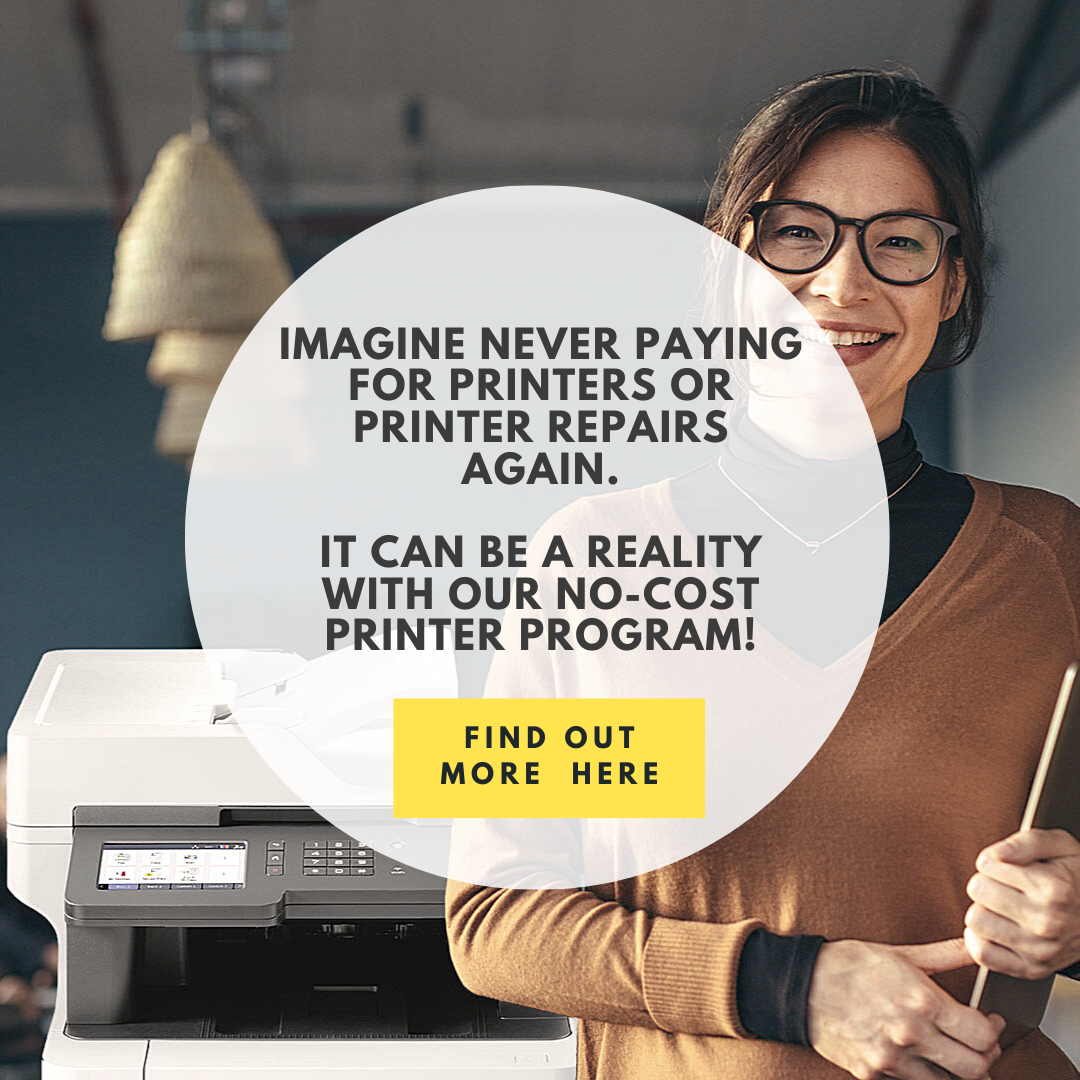Psst…here’s a secret: September to the end of December is what we in the printing biz call “Printer Buying Season.” What does that term mean? It means that companies are going crazy obtaining printers while other companies are going crazy providing them – all in a concerted effort to clear ledgers or settle inventory for the new year.
It’s an ideal time for your office to secure the latest and greatest printing device. However, without knowledge of printers and self-knowledge of printing needs, your office might end up with a printing lemon, ink-guzzler, or copying clunker. What’s more, there are several ways to obtain a business printer; and many of these ways overlap and can make a difference in your budget and productivity.
Here are the four ways to acquire a business printer, including their pros and cons, followed by the questions you should answer before going down that printing rabbit hole. (This information will help you all year-long).
Buy a printer
You purchase the printer. That’s about it. Online, offline, through a dealer. You can do whatever you want to it, including breaking it with a bat ala Office Space.
Pros:
- You own it
- You can move it
- No hardware contracts
Cons:
- Upfront capital cost
- Can’t upgrade
- Pay extra for toner and service
Lease a printer
You make monthly payments for 3-5 years with the option to purchase the printer or copier for fair market value at the end of the lease.
Pros:
- Less money upfront
- 100% operating expense
- Easy to upgrade
Cons:
- 3-5-year lease commitment
- Upgrading causes refinancing
- Pay extra for toner and service
Pay cost-per-page
Printer stays in your office, but you pay by the printed page and agree to a minimum monthly volume commitment regardless of actual usage.
Pros:
- Predictable budgeting
- Printer service and toner included
- Single invoice
Cons:
- Minimum print volume commitment
- Paying for unused prints
- Annual escalators and overage fees
Why Buy a Printer?
This program is our innovation to the printer and copier industry. You receive the printer and printer service at no additional charge if you buy your toner from Cartridge World.
Pros:
- Printer and service include
- Only pay for the toner you use
- Save up to 30% on big brand prices
Cons:
- You don’t own the printer
- Printer must stay local
Here are the questions you need to ask yourself and your colleagues before deciding on any of the routes to acquiring a printer.
Are you thinking about the “life cycle” costs?
Thought leaders in the printer and copier industry have told us that people need to think beyond the printer itself and consider the “Lifecycle Cost” of acquiring AND operating a business printer. In case you haven’t purchased an office printer recently, the operating costs that include printer service and toner are far higher than the price of the printer itself. This model is like the razor blade model, where companies make their money from razor cartridges and not the handles.
Here is the average lifecycle cost breakdown:
- Printer Service and toner: 60 percent
- Printer hardware: 40 percent
In short, look to the future to see how much a printer will impact your budget, with possible breakdowns on the horizon. Keep in mind that the expected lifespan of an inkjet printer is three years, and the lifespan of a laser printer is five years. In this time, your business printer ideally will only break down once a year.
Is printer service included?
Printers tend to be more reliable than bigger copiers and multifunction printers. Why is that? Inkjet and laser printers have far fewer moving parts. With that said, business printers do have quality issues, paper jams, and other problems that involve service attention (and can drive you to wanting to get a bat).
In the absence of a service coverage program provided by a third party, untrained employees are often asked to fix the business printer. This can be distracting, time-consuming, and sometimes dangerous. It’s just not a good optic for a business.
Do you anticipate your needs changing?
When you purchase a printer for your business, you are pledging to that specific imaging device with no option to change as newer technologies become available. Most businesses prefer the flexibility to upgrade their printer as capabilities in security protection, mobile printing, and cloud integration develop with the increasingly fast pace of technology. When you lease or go for a printer program like Why Buy a Printer?, you have the option to upgrade, similarly to how people can do with their smartphones with certain carriers.
Are you a non-profit or for-profit organization?
In the past, most “for-profit” organizations elected to lease their business equipment because they can would off 100 percent of their business printing costs as an operating expense. Newer acquisition models also offer this tax benefit and are quickly replacing the preference to lease.
On the other hand, “not for profit” organizations prefer to buy printers outright as a capital expense and depreciate the printer like any other asset.
I know all this content may seem like a lot. To further help you out, please check out our Printer Acquisition Matrix:

You know which one of these programs we at Cartridge World would prefer. But at the end of the day, it depends on your office printing needs. What’s important is that you get the right printer or imaging device that works on the day you need it to work. Everything else is negotiable, even using a bat on your printer like in Office Space.
If you need further help, please check out these articles on acquiring the right printer for your business:
How To Choose A Printer: The Seven Deadly Sins Of Buying One
The Top Small-To-Medium Business Printers
10 Myths About Printing That Might Be Increasing Your Printer Cost
Should Your Office Have A Printer Or Copier?
Or download our free eBook on acquiring a business printer.
Here’s another secret: In January, cartridge and toner buying season begins. Those printers don’t stock themselves, you see, and we’ll be with you then with more tips.
Please contact us if you need any printer buying advice, or if you’re interested in finding out more about our Why Buy a Printer Program?







